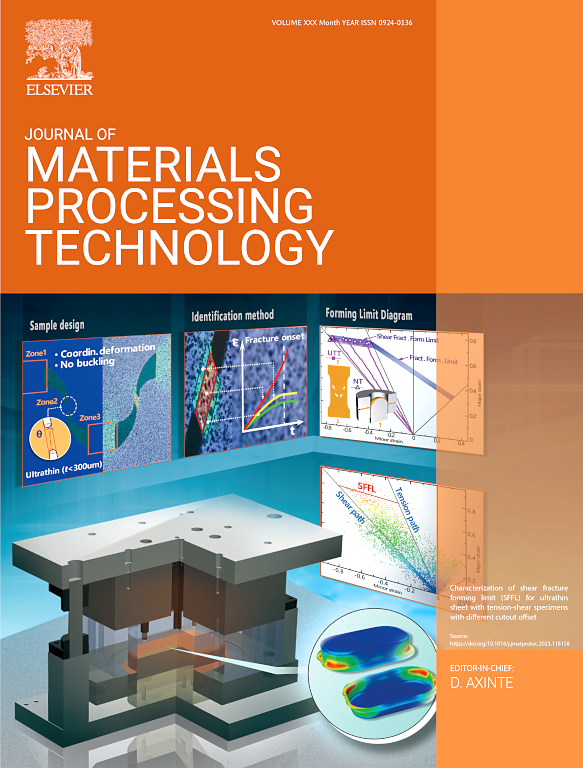Analysing the reduction in buckling limit of a flexible roll formed flange due to shape imperfection
IF 6.7
2区 材料科学
Q1 ENGINEERING, INDUSTRIAL
Journal of Materials Processing Technology
Pub Date : 2025-02-15
DOI:10.1016/j.jmatprotec.2025.118767
引用次数: 0
Abstract
Flexible roll-forming can form high-strength sheet metals into components with complex cross-sections but widespread application is limited by flange wrinkling. Previous work has suggested that the low buckling limit in flexible roll forming may be due to the local contact of the forming roll with the metal sheet which produces an imperfection in the flange. In this study, a new plate buckling test is presented and applied to study the effect of imperfections on the buckling limit for conditions that represent flange deformation in flexible roll forming. This is combined with a finite element analysis approach to determine the level of imperfection in a flexible roll formed flange and used to estimate the reduction of the flange buckling limit due to shape imperfection. The results of this study provide for the first time experimental and analytical evidence that the theoretical buckling limit in a flexible roll formed flange is significantly reduced by flange imperfections. The experimental plate buckling test combined with the finite element analysis method for estimating imperfection levels enables the analysis of the effect of forming parameters and geometric conditions on flange imperfection and buckling behaviour and therefore provides a promising alternative to conventional finite element analysis for flexible roll forming process optimisation.
分析了形状缺陷对柔性辊形法兰屈曲极限的影响
柔性滚压成形可以将高强度金属板材加工成具有复杂横截面的部件,但由于法兰起皱问题,限制了其广泛应用。以前的工作表明,柔性辊成形中的低屈曲极限可能是由于成形辊与金属板的局部接触而在法兰上产生缺陷。在本研究中,提出了一种新的板屈曲试验,并应用该试验研究了柔性辊压成形中代表法兰变形的条件下缺陷对屈曲极限的影响。该方法与有限元分析方法相结合,用于确定柔性辊轧成形法兰的缺陷程度,并用于估计由于形状缺陷导致的法兰屈曲极限的减少。本研究的结果首次提供了实验和分析证据,证明在柔性辊轧成形法兰的理论屈曲极限被法兰缺陷显著降低。实验板屈曲试验与缺陷程度估计的有限元分析方法相结合,可以分析成形参数和几何条件对法兰缺陷和屈曲行为的影响,从而为柔性辊压成形工艺优化提供了一种有希望的替代方法。
本文章由计算机程序翻译,如有差异,请以英文原文为准。
求助全文
约1分钟内获得全文
求助全文
来源期刊

Journal of Materials Processing Technology
工程技术-材料科学:综合
CiteScore
12.60
自引率
4.80%
发文量
403
审稿时长
29 days
期刊介绍:
The Journal of Materials Processing Technology covers the processing techniques used in manufacturing components from metals and other materials. The journal aims to publish full research papers of original, significant and rigorous work and so to contribute to increased production efficiency and improved component performance.
Areas of interest to the journal include:
• Casting, forming and machining
• Additive processing and joining technologies
• The evolution of material properties under the specific conditions met in manufacturing processes
• Surface engineering when it relates specifically to a manufacturing process
• Design and behavior of equipment and tools.
 求助内容:
求助内容: 应助结果提醒方式:
应助结果提醒方式:


